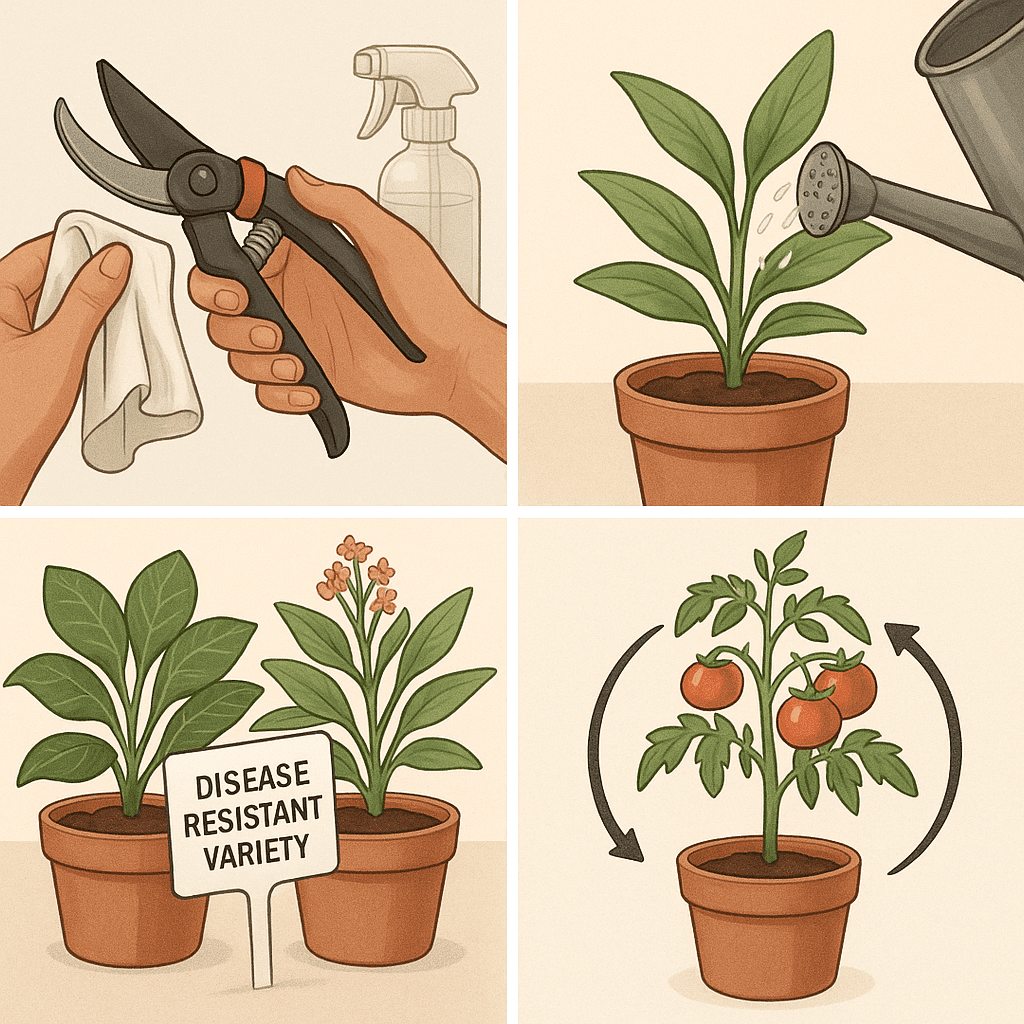If you love gardening, knowing how to identify and treat the 5 most common plant diseases is essential to protect your plants and keep your garden thriving. Early detection and proper treatment can mean the difference between a healthy garden and a rapid spread of infection.
In this guide, you’ll learn how to spot common plant diseases, understand their causes, and apply effective solutions to control or eliminate them.
Why Plant Disease Management Matters
Plant diseases are more than just a cosmetic issue — they can kill your plants, spread rapidly to others, and ruin entire garden seasons. Learning to recognize early signs of disease helps prevent costly losses and promotes a healthy, sustainable garden.
Common Causes of Plant Disease
- Fungal spores in moist environments
- Insects spreading bacteria or viruses
- Contaminated soil or gardening tools
- Overwatering or poor drainage
- Lack of air circulation between plants
1. Powdery Mildew
How to Identify:
- White or gray powdery substance on leaves, stems, or flowers
- Affected leaves may become distorted or yellow over time
Cause:
- Fungal spores that thrive in dry climates with high humidity and poor air circulation
Treatment:
- Remove infected leaves immediately
- Apply neem oil or a homemade spray (1 tbsp baking soda + 1 tbsp dish soap in 1 liter of water)
- Improve spacing and air flow between plants
2. Root Rot
How to Identify:
- Wilting despite moist soil
- Yellowing or browning leaves
- Mushy, dark roots when removed from soil
Cause:
- Overwatering and poor drainage create an environment for fungal growth
Treatment:
- Remove the plant from the soil and trim away affected roots
- Repot with fresh, well-draining soil
- Reduce watering and ensure proper drainage holes in pots
3. Leaf Spot
How to Identify:
- Brown, black, or yellow spots on leaves
- Spots may have a halo or target-like pattern
- Leaves may fall prematurely
Cause:
- Fungal or bacterial infection spread through rain splash or contaminated tools
Treatment:
- Remove and discard infected leaves
- Avoid overhead watering
- Use a copper-based fungicide if the problem persists
4. Blight
How to Identify:
- Sudden browning or blackening of leaves and stems
- Wilting of new growth
- Fruit or flower rot in later stages
Cause:
- Fungal infection that spreads rapidly in warm, wet conditions
Treatment:
- Remove all infected parts and destroy them (do not compost)
- Apply fungicides designed for blight
- Rotate crops and avoid planting in the same soil every year
5. Rust
How to Identify:
- Orange, yellow, or reddish spots on the underside of leaves
- Pustules may release powdery spores when touched
- Leaves may become dry and fall off
Cause:
- Fungal spores spread by wind or water
Treatment:
- Prune and dispose of affected leaves
- Apply sulfur-based fungicide
- Improve air circulation and avoid overhead watering
Step-by-Step: General Disease Prevention Tips
1. Sanitize Tools Regularly
Always clean your gardening tools with rubbing alcohol or a bleach solution to prevent spreading pathogens.
2. Water Wisely
Water at the base of the plant in the morning to reduce moisture on foliage and prevent fungal growth.
3. Choose Disease-Resistant Varieties
When possible, select plant varieties labeled as resistant to common diseases in your region.
4. Rotate Crops in Garden Beds
Avoid planting the same family of plants in the same spot each year to reduce soil-borne disease buildup.
5. Inspect Plants Before Buying
Always check new plants for signs of disease or pests before introducing them to your garden.

To prevent many of these plant diseases, it’s essential to water your plants correctly — check out our complete guide on watering plants the right way.
Conclusion: Healthy Plants Start with Early Detection
Understanding how to identify and treat the 5 most common plant diseases empowers you to act fast, protect your garden, and maintain beautiful, thriving plants. Whether you’re a beginner or seasoned gardener, applying these techniques can dramatically improve your results.
🌿 Save this guide for your next planting weekend!
🌼 Share it with a friend who’s struggling with sick plants!
FAQ – Plant Disease Identification & Treatment
Can I save a plant after it’s infected with disease?
Yes, in many cases. Early detection and removing infected parts can stop the disease from spreading.
Are organic treatments effective for plant diseases?
Yes. Neem oil, baking soda sprays, and copper-based solutions are natural options with proven results.
Should I isolate a diseased plant?
Absolutely. Isolating it prevents the spread to nearby healthy plants, especially in small garden spaces.
You can find high-quality neem oil and copper-based fungicides for disease treatment at Gardener’s Supply Company.
Written by Kate Smith | Plant Care Enthusiast & Urban Gardener

[…] For more tips on identifying and treating plant issues, check out our guide on common plant diseases and how to treat them. […]